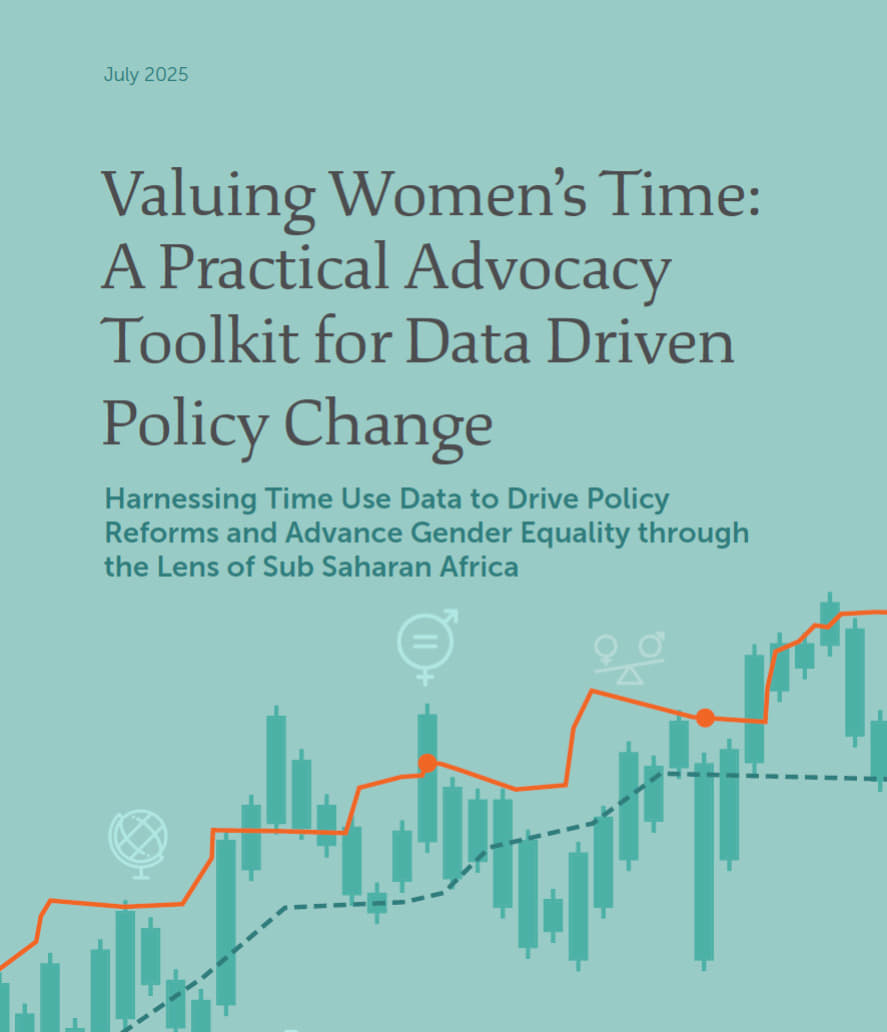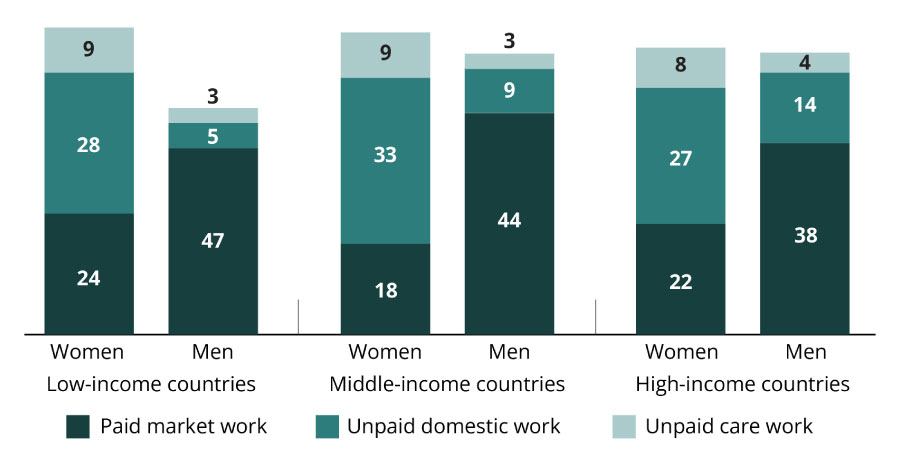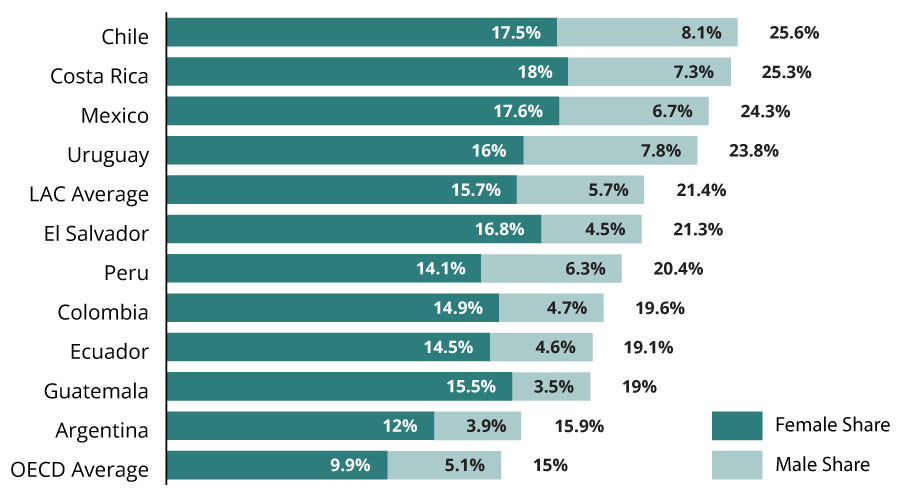Edition October 2025


Prepared by Open Data Watch and Data2X
What Time Will Tell:
Understanding Time Use Data to Shape Better Policies
Time use data have a wide range of applications, from informing social protection and care policies to evaluating environmental or macroeconomic policies. Time use data quantify the time people spend in unpaid and paid work, reflecting the gendered division of labor and women’s real contribution to the economy.
Time use data are most often collected through household-based surveys (diaries). These surveys record all activities that individuals undertake in a 24-hour period. This includes time spent on unpaid domestic, care, volunteer work, and other daily activities. These data shed light on the full range of activities that have economic and social value.
This brief explores what time use data are and what they can offer. It shares examples of policies that time use data have already started to inform and evaluate in different countries. It also provides an overview of the Valuing Women’s Time toolkit to help advocates harness the great potential of time use data. This brief is intended for policymakers, gender advocates, and data specialists seeking to improve policy outcomes through time use data.
Key Messages:
- Time use data reveal women’s work burdens and contributions from spending more time than men on unpaid domestic and care work, regardless of countries’ economic status.
- Time use data can help inform and monitor a wide range of public policies, including care, education and training, labor, infrastructure, economic, and better valuing GDP.
- The Valuing Women’s Time toolkit provides practical guidance and support to help advocates mobilize time use data for policy impact.
- To realize the complete potential benefits of time use data to inform policies, continued investment, innovation, and policy engagement will be essential.
Trends in time use data
Time use data quantify how people spend their time, revealing gender-relevant trends. One trend around the world is that women, on average, spend more time on unpaid work than men such as household tasks and caregiving. And relatedly, women spend less time on paid work. Figure 1 illustrates this by breaking down the average number of hours married women and men spend on paid and unpaid work each week. And it highlights how this varies depending on their country’s economic status.
Figure 1: Average number of hours spent per week by gender, work type, and country economic status
Note: This analysis is based on a harmonized dataset containing 77 nationally representative surveys carried out in 50 countries from 1965 to 2021.
Source: Gottlieb, C., et al. (2024). The gender division of work across countries. https://www.iza.org/publications/dp/16896/the-gender-division-of-work-across-countries
These data show that across all country income levels, married women spend an average of around 40 hours per week on unpaid work. This includes both unpaid domestic and care work. While the time spent on domestic work varies slightly with country income level, the time spent on care work is constant across all income levels at around 9 hours per week. Married men spend significantly less time than married women on unpaid work, around 13 hours on average across all countries, with time increasing with countries’ higher income levels.
These data also reveal the gap between the number of hours married women and men spend on paid or “market” work. Women engage in fewer hours of market work than men, with a ratio of 48 percent average across all countries. Men’s time spent in market work declines from an average of 47 hours per week in low-income countries to 38 hours in high-income countries.
As time use data quantify the time spent on unpaid work, it becomes possible to calculate the economic value of that work. A country’s gross domestic product (GDP) provides a measure of its economic activity, traditionally excluding the value of unpaid work. Adding the contribution of unpaid work to a country’s GDP calculations provides a more comprehensive measure of economic activity. Figure 2 shares findings from the United Nations Development Programme (UNDP) showing that in Latin America and the Caribbean (LAC), unpaid care work is equivalent to 21 percent of GDP, with women contributing three-fourths of this share.
Figure 2: Gender Contributions to Unpaid Care Work as Share of GDP, %
Note: The data reported for each country are the most recent available; Mexico (2022), Colombia and Uruguay (2021), Argentina and Chile (2020), Costa Rica and Ecuador (2017), Guatemala (2014), El Salvador and Peru (2010). The regional average is calculated as a simple average of values from countries in Latin America and the Caribbean (LAC). Original data compiled by UNDP from OECD (2022) and satellite accounts of care for each country.
Source: United Nations Development Programme. (2024). “The Missing Piece: Valuing women’s unrecognized contribution to the economy.” UNDP in Latin America and the Caribbean Blogs. https://www.undp.org/latin-america/blog/missing-piece-valuing-womens-unrecognized-contribution-economy
Each of these countries would show a large increase in their GDP if unpaid work were included in its calculations. And not only do these calculations reveal the significant contribution of unpaid care work, but they also reveal the large disparities that exist between the unpaid contributions of women and men. When countries include unpaid work in their economic data, they can better design programs that improve access to paid work, especially for women. These programs can help make the economy more efficient, like by cutting down commute times to paid work. They can also support long-term growth, such as by increasing access to job training to help people move into better-paying work.
Where time use data shape better policies
Across the world, time use data are driving real policy change. This section shares examples of where and how.

Shaping care policies to address labor market barriers
Time use data reveal the uneven distribution of unpaid care work which creates labor market barriers. This informs the design of social protection and care policies, including childcare, eldercare services, and parental leave policies.

Photo: Chatchai Somwat [Shutterstock]
In South Korea, time use data have informed efforts to create greater work-family balance and better childcare support. Local governments have used National Time Transfer Accounts derived from time use survey data to inform the size of allowances paid to grandparents caring for children.[1]
In Senegal, the 2021 time use survey showed that women spend 2.5 times more time on unpaid work than men. Results like these prompted the Ministry of Women, Family and Child Protection (MFFPE) to revise policies related to women’s empowerment and entrepreneurship and launch new initiatives.[02]

Designing and evaluating education and training programs
Time use data reveal shortcomings in the time devoted to studying and time constraints affecting access to education and training programs. This makes it possible to evaluate and inform efforts to improve access to these programs.

Photo: SALMONNEGRO-STOCK [Shutterstock]
In Mexico, the government analyzed time use survey results to evaluate the impact of a national conditional cash transfer program (aimed at low-income families). They found that beneficiary teenagers spent twice as much time studying as their non-beneficiary peers, which justified program continuation.[3]
In Ecuador, a time use survey showed that gender and wealth differences affected time spent on schooling, working, and household tasks. This can help policymakers design targeted interventions to promote education access and participation during school disruptions.[4]

Improving infrastructure access and urban planning
Time use data shed light on the daily routines of women. This reveals how infrastructure investments can be improved and result in more inclusive services.

Photo: Snehal Jeevan Pailkar [Shutterstock]
In India, the Government of Delhi’s “pink pass” program offered free bus travel to female riders to improve access to paid work. Analyzing time use data showed women from marginalized households gained up to 150 minutes per week in paid work and increased employment by 24 percent.[5]
In Uganda, household surveys since the 1990s have shown the daily time burden of water collection on rural women, informing the 1999 National Water Policy. In 2004, the Sector Performance Measurement Framework adopted “average time to collect water” to track progress in the water and sanitation sector.[6]

Measuring impacts of environment and climate policies
Time use data illustrate how environmental issues translate into time burdens. This makes it possible to quantify the impact of technological advancements to address climate-related challenges.

Photo: Sebastian Castelier [Shutterstock]
In Kenya, the government’s 2023 National e-Cooking Strategy prioritizes reducing the burden of fuel collection and cooking time for women, highlighting time savings as a key benefit of clean cooking solutions. The 2021 Time Use Survey measures cooking and fuelwood collection to help monitor this strategy.[7]
In Honduras, the Improved Firewood Cookstoves Program, part of the FOCAEP initiative, installed “Justa” clean cookstoves designed to reduce fuel consumption and improve cooking efficiency. This project measured the time saved by women who previously spent many hours daily collecting firewood and cooking.[8]

Expanding economic measurement
Time use data illuminate the scope and value of unpaid care and domestic work. This makes it possible to calculate the economic impact of this work, informing public discourse and policies.

Photo: Michalakis Ppalis [Shutterstock]
In Finland, national accounting exercises based on time use data revealed that unpaid work would increase its GDP by approximately 40 percent if it were counted. This has been used to support arguments for better care infrastructure and work-life balance policies.3
In South Korea, time use data have helped calculate the value of unpaid household labor at roughly 490.9 trillion KRW (about $400 billion), equivalent to nearly half of formal GDP. This informed political discourse during the 2022 local elections, with candidates proposing a “household labor allowance.”3

Other areas: agriculture and health
Time use data offer a wide range of additional potential uses. They can reveal barriers to agriculture, health, or labor markets or can identify when women in rural areas are most available for service delivery.

Photo: Nick Fox [Shutterstock]
In Ethiopia, a study analyzing time use data found that women had weaker access to resources and social networks, resulting in poor nutrition. The Ethiopian government used these findings to implement new strategies to improve women’s participation in agriculture and other economic activities.[9]
In the United Kingdom, during the 1920s and 1930s, time use diaries were used to optimize the timing of public service delivery. These examples have been cited in policy discussions about how time use data could improve delivery of health and agricultural services.[10]
Revealing the uneven distribution of unpaid care work, time use data have informed the design and implementation of policies that open doors for women and girls, expanding access to education, childcare, health, and employment, and improving the quality of life for families and communities. And from justifying the continuation of a conditional cash transfer program promoting access to education in Mexico to monitoring the impact of infrastructure investments in Uganda, time use data have also proven critical in monitoring and evaluating public policies of all kinds. Furthermore, these data can help calculate the true economic impact of unpaid household labor.
These cases show how time use data are not only crucial for designing but also evaluating policies that expand access to education, childcare, health, and employment, and improving the quality of life for families and communities. However, to achieve the full potential of time use data for advancing gender equality, concerted effort and sustained support are needed.
A toolkit for harnessing time use data
There are many opportunities for time use data to help inform and monitor effective public policies, but these data can only drive change when paired with solid arguments and compelling messaging to reach and influence policymakers. The Valuing Women’s Time toolkit, developed by Data2X, provides practical guidance and support to help advocates harness the great potential of time use data to drive policy reforms and advance gender equality.

This toolkit provides advocates with:
- A step-by-step guide for turning time use data into effective gender policy advocacy.
- Sample templates to support planning, messaging, and stakeholder engagement.
- Message frameworks tailored to sectors like care, labor, agriculture, transport, and social protection.
- Case examples from Sub-Saharan Africa to ground advocates’ work in local realities.
- Practical advice for adapting advocacy to urban, rural, and sub-national contexts.
This toolkit centers around a six-step advocacy process, designed to help you apply time use data to policy reform. Each step includes actionable tools, real-world examples, and practical guidance. Below are the steps for which the toolkit offers templates:
Collective action for time use data
Recognizing the value of time use data is the first step toward integrating gender-sensitive insights into national policy-making. However, such detailed insights also come with high costs and complexity to production, resulting in limited frequency. To overcome these challenges, the right tools and sustained collective action will be needed across these areas:
- Investment in efficient time use modules to promote uptake and use. Time use modules attached to larger surveys offer an efficient and light means of collecting these data.
- Innovation through new data sources and artificial intelligence to close gaps. Citizen data and artificial intelligence offer opportunities to improve data production and close gaps.
- Policy engagement to build awareness among users and ensure use for impact. Continued engagement with policymakers will be critical to ensure that the enormous potential of time use data is fulfilled.
Country Example Sources
[1] Data2X. (2025). Role of Time Use Data in Policymaking in South Korea. https://data2x.org/wp-content/uploads/2025/02/South-Korea-TUCS-WR-250225.pdf
[2] Ross, Jen. (2023). “Time-use data in Senegal spur advocacy, policy and programme revisions.” UN Women Stories. https://data.unwomen.org/features/time-use-data-senegal-spur-advocacy-policy-and-programme-revisions
[3] Data2X. (2018). Invisible No More? Country Case Studies. https://data2x.org/wp-content/uploads/2019/05/Data2X-Invisible-No-More-Volume-2.pdf
[4] Asanov, I., Flores, F., McKenzie, D., Mensmann, M. and Schulte, M. (2021). Remote-learning, time-use, and mental health of Ecuadorian high-school students during the COVID-19 quarantine. World Development, Vol. 138, 105225. https://www.sciencedirect.com/science/article/pii/S0305750X20303521?via%3Dihub
[5] Dasgupta, Aparajita and Datta, Ashokankur. (2023). Gendered Transport Subsidy and its Short Run Effect on Female Employment: Evidence from Delhi’s Pink Pass Scheme. https://dp.ashoka.edu.in/ash/wpaper/paper105_0.pdf
[6] Ministry of Water, Lands and Environment (Uganda), & IRC International Water and Sanitation Centre. (2004). Uganda water and sanitation sector performance measurement framework. https://www.ircwash.org/sites/default/files/824-UG04-18235.pdf
[7] Ministry of Energy and Petroleum. (2024). Kenya National electric Cooking Strategy. https://www.energy.go.ke/sites/default/files/KAWI/Publication/KNeCS Strategy Main Document_Draft 4.pdf
[8] W+. (n.d.) Improved Firewood Cookstoves Programme, Honduras. https://www.wplus.org/project/improved-cookstoves-honduras/
[9] Myers, Emily. (2022). “Lessons from a decade of the Women’s Empowerment in Agriculture Index (WEAI)” IFPRI Blog. https://www.ifpri.org/blog/lessons-decade-womens-empowerment-agriculture-index-weai/
[10] Data2X. (2018). A Methodology and Policy Review of How Time Use Surveys Measure Unpaid Work. https://data2x.org/wp-content/uploads/2019/05/Data2X-Invisible-No-More-Volume-1.pdf
—
Acknowledgments
This brief summarizes the Role of Time Use Data in Policy Making: Valuing Women’s Time and Care Work report with lead author Mayra Buvinic, Senior Fellow at UN Foundation and Data2X. It was developed by the Open Data Watch team with Amelia Pittman, Data Insights and Design Manager, in the lead with inputs from other team members.
Cover photo credit: Quang nguyen vinh (Shutterstock.com)









